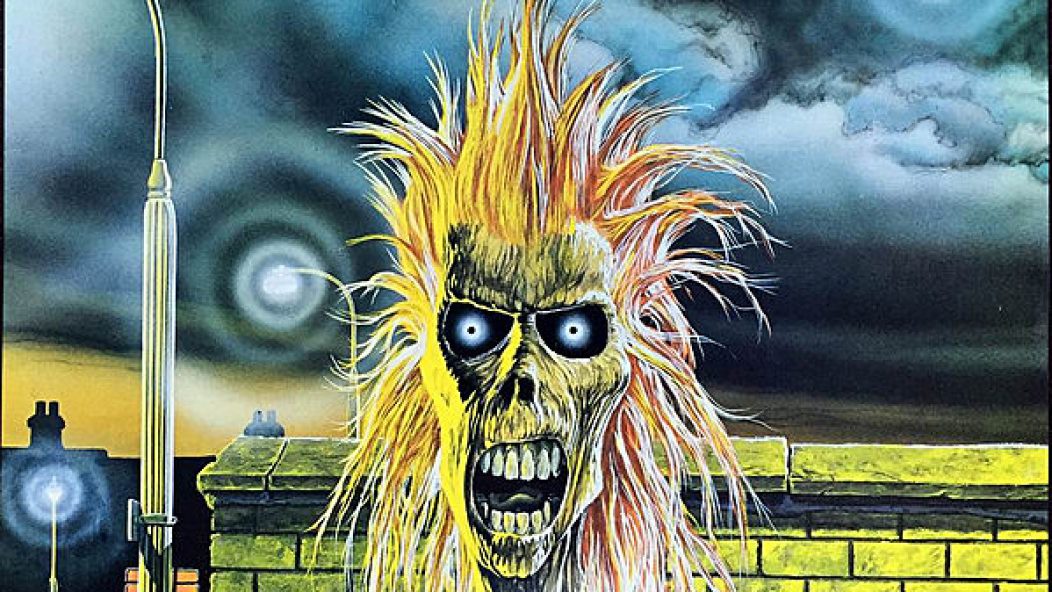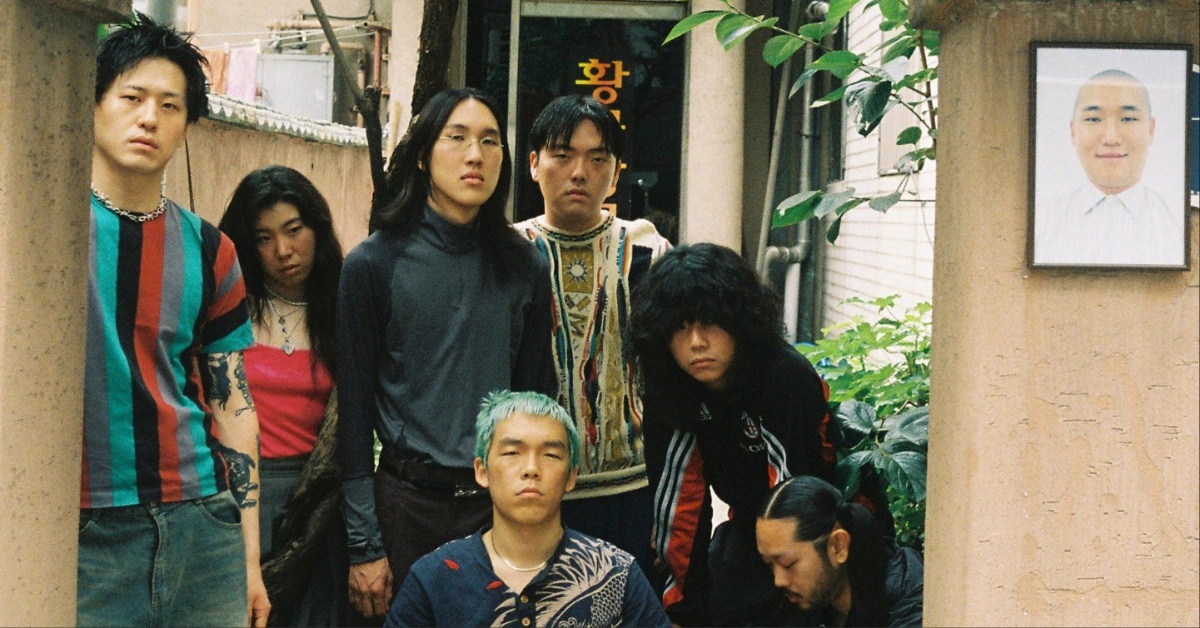
Iron Maiden's Wild and Extraordinary Self-Titled Debut Turns 40
…
Iron Maiden’s debut self-titled album is one of those monumental moments in the history of metal music — not quite akin to the big bang Black Sabbath established ten years prior, but certainly a revolution that took what Sabbath established into newer realms. Iron Maiden were indebted to many others who came before like Led Zeppelin, Deep Purple, Rainbow, Scorpions, and most certainly Judas Priest. They were part of the New Wave of British Heavy Metal (NWOBHM), a new generation that pulled musically from many of those previous bands but established a leaner and more contemporary presence aligned with the cultural osmosis from punk rock’s explosion. Some would argue such an influence is exaggerated or only aesthetic, but that overlooks some undeniable punk-provided street smart attitude that bolstered the upcoming crop of metal, whether in Iron Maiden, Angel Witch, Diamond Head, Saxon, Venom, or others.
For Iron Maiden, the punk influence hung closely with then-singer Paul Di’Anno, their third vocalist since the band’s late 1975 founding, where his gruff but melodic voice wrapped up in pierced ears and leather ‘n’ studs certainly brought the band closer in attitude to bands like The Damned or even punk-friendly, long-haired, proto-speed metallers Motörhead. Another legacy of punk was the DIY approach in touring and promotion. While that independent commitment to push themselves made them a stronger unit — resulting in numerous member departures as many musicians came and went before the debut album was recorded — it certainly didn’t hold Iron Maiden back from seeking grander heights as they became one of only two bands from the scene to sign with a major record label (the other being Sheffield’s future pop metal stars Def Leppard). It was EMI who signed Iron Maiden, the same label that had a notorious falling out with punk iconoclasts The Sex Pistols before even completing their first album.
Iron Maiden found plentiful support from their big label who seemingly never tried to pressure the group to abandon their sound for more pop friendly ventures. Alongside the label support came personal guidance under band manager Rod Smallwood who aggressively pushed the band to tour and made numerous promotional decisions that would propel the band ever higher. One fine example being the creation of Eddie, Iron Maiden’s hooligan-looking monster who has traveled through space and time on most of the band’s artwork thanks to artist Derek Riggs whom Smallwood sought out. Rigg’s original piece ironically enough was at first intended for a punk band and was based on an image he claims to have witnessed somewhere of an American soldier’s head propped onto a Vietnamese tank. Smallwood knew that the band needed an image as no one in the group had a particularly gregarious personality, many members by Smallwood’s account were calm and well mannered off stage, and Eddie was able to fit that perfectly. To this day it’s the ever changing but somehow still constant image of Eddie that is the most memorable visual aspect of the band to the point it’s no exaggeration to say he might be the biggest mascot in rock history.
Iron Maiden’s rise from hungry pub band to metal godhood truly launched when their self titled debut released and changed the world forever 40 years ago. In short order, they became the first band since The Who to demand their performance on the famous Top of the Pops program be a live performance, and they gained legions of fans while opening for Kiss across Europe. By 1984, along with even more lineup changes for three-fifths of the band, Iron Maiden would be playing the largest arenas in the US, including one not far from where I sit now where future vocalist Bruce Dickinson belted out the immortal metal line “Scream for me Long Beach!”
— Joe Aprill
…
…
Ted Nubel
Iron Maiden sent the metal world in a new direction. Although the band would undergo numerous changes, their first self-titled offering holds a raw, blazing appeal that inspired an entire scene. Between the crunchy guitar tones, punchy drum production that sits just beneath the bass, and the rough, demented vocals of Paul DiAnno, blistering and unforgettable tunes like “Phantom of the Opera” carved their intense melodies into my brain, serving as a foundation for evaluating all the metal I heard after that point.
My first exposure to Iron Maiden was through The Trooper, actually, but after one listen to that, I set upon uncovering their full discography where I found that, before Bruce Dickinson, they had already forged a diehard brand of metal that carried with it an untamed menace just as daring as their later work. Only with original Iron Maiden, they slay in a back-alley-with-a-knife way as opposed to the charging-out-of-a-trench variety of later years.
Clive Burr, who drummed on the first three albums, set the compositions apart — light on showy fills and heavy on small accents and ghost notes, he transferred the feel of a bluesy groove to high speed metal — and while I love Nicko McBrain’s drumming on later albums, there’s certainly a difference in execution here that added ferocity to the high-octane rippers on the first few albums.
Even after numerous lineup changes, the album features heavily in live performances — “Iron Maiden,” particularly, is a staple of the band and a defining part of their live show, and for good reason — it’s energetic, timeless, and singularly relentless. Iron Maiden, packing some of the most potent energy ever lent to heavy metal, sounds every bit as deranged as the band’s mascot/cover art subject, and the sheer, reckless insanity is timeless in its inimitability.
…
…
Andrew Rothmund
How I knew Iron Maiden was legit before ever knowing they were for-real legit: their albums sounded top-notch at high speeds, and tire squeals only enhanced this effect. My turning point in heavy metal coincided with the acquisition of my driver’s license; the fact that my first car was a goddamn dog in every way except for the kickass stereo meant that the only real way to have fun was with the thing cranked and the pedal mashed. And, of course, as albums like Powerslave and Piece of Mind hit their climaxes, as did I, alone, slightly terrified, but fucking electric all the same.
And that’s why Iron Maiden is not rock-‘n’-roll, or punk, or anything else other than heavy metal, despite obviously borrowing from those spaces to generate their own brand and mix. Even though my first Iron Maiden albums were those 1983 to 1988 ones, it wasn’t long until I looked backward to the beginning: Iron Maiden, the noise that would go on to help define NWOBHM and, well, metal at large too. If heavy metal has any household names for real, Iron Maiden is one of them, and this outcome was not hampered in any way by the band’s debut. And even though Bruce Dickinson gets so much rep, you have to say this about Di’Anno: yes. Yes, because it was right in every way: timbre, tone, and talent, the OG Iron Maiden is sometimes the only way to go.
Iron Maiden might feel prototypical under the future light of absolute madhouse-good albums like Piece of Mind, but what those later albums lack is the raw grit that only debut albums can possess. Even then, most band’s debuts don’t have it, and when they do, they don’t often resolve into world-leading reputation and fanship. Iron Maiden didn’t have to propel the band toward The Glamorous Future — the band wasn’t successful in the end solely because of their debut. But, without it, nobody would have given a damn in the first place.
Down to the music. I suffer from a horrible brain condition described as “the uncontrollable impulse to listen to so much new music every fucking day that there’s just no time to pay respects to old classics.” So, take my word for what it is, as someone who hasn’t listened to Iron Maiden since being a teenager: Iron Maiden is great in so many ways more than just those perfect for high-speed antics or another adolescent asshattery. The band, on their very first album, showcased the delicate and riffy musicianship which would later evolve into a full-blown technicality endemic to their whole gig. I mean, just listen to “Phantom of the Opera” and call it anything but techy old-school heavy metal, I dare you.
I can only imagine the face-ripping grins that the EMI folks had when they were let onto Iron Maiden — you can obviously hear it, how good this band is, but to witness it, discover it, and feel it first-hand must have been uncompromisingly ecstatic, even more so when money is on the line. Clearly, though, someone knew their shit — Iron Maiden knew their shit, too — and now we have one of the greatest albums ever written by one of the greatest heavy metal bands of all time. I wasn’t even alive in 1980, but even that doesn’t matter when it comes to this album. It transcends context — it is context.
Over and out.
…
…
Joe Aprill
I came to Iron Maiden not long after I started my journey into metal during my initial teenage years in the early 2000s, though I encountered it after already diving deep into later albums like Powerslave and Piece of Mind. My immediate reaction, like with any Maiden album, was visual: the already fantastical images of Eddie I’d familiarized myself with gave way to something far more primal and feral on this debut. Eddie here looks like a madman, either propelled by drug or supernatural energy behind his dead-set eyes, ready to axe the view as the subsequent Killers album cover depicted. All of my Iron Maiden albums from back then were the 1998 re-issued/remastered CDs that contained two live or music video performances of tracks from each respective album. For 1980’s Iron Maiden, included were the live recordings from the band’s first VHS release Live at the Rainbow, where the raw youthful energy of the band seemed to drill out from my bedroom computer screen directly into my slack-jawed face.
Di’Anno seemed to embody a level of absolute coolness as he crooned and shouted while decked from shoulder to toe with deep black leather and silvery sharp studs.
One of those songs he performed for the set at the Rainbow instantly became a favorite of mine, “Phantom of the Opera.” Years earlier, as a very young kid, the soundtrack for Andrew Lloyd Webber’s similarly titled musical stage adaptation of the original 1910 French novel was one the first works of music that my parents gave to me (at that time in the form of a cassette tape). It left a large impression on me, influencing some of my later artistic taste, and most assuredly had a hand in my immediate love for Iron Maiden’seven earlier tribute to the masked haunter of the stage (which was most likely inspired from the Lon Chaney starred silent film adaptation of 1925). The song is the band’s first real shot at more epic and progressive work that would become a far more common staple later in their career where dynamic song structure, galloping base lines, and intricate melodic guitar work pulled just as much from classical music as rock-‘n’-roll. For me, it’s a strong favorite because the song serves as a full journey taking you somewhere beyond the mundane, which is perhaps one of the best traits to be found when metal really shines its brightest. I was also beyond overjoyed, to the point of bouncing around and shouting like a maniac on the hill, when at my first witnessing of Iron Maiden in the flesh at their Irvine, California performance in 2012, they played “Phantom of the Opera.” Pure elation and overpriced beer ran through my veins at that moment.
“Remember Tomorrow” shows a real command for light and heavy dynamics paired with honey sweet crooning, a song so popular it’s been covered by numerous bands in different styles including Opeth and Uncle Acid & the Deadbeats. Or, the odd gem “Charlotte the Harlot,” which is perhaps too borderline misogynistic these days, is still unmistakably catchy and adds to the band’s grit reflective of working class life in the London of the late 1970s. It should also be said Iron Maiden were hardly the only ones to cover such a topic at the time, as many did, including Black Sabbath, Queen, The Police, and more.
With a heavy mix of various musical influences, road-hardened determination, and a breath of luck blown under their feet, Iron Maiden launched with their debut album a career that would last them almost half a century and help form the bedrock for heavy metal. So whether it’s your 400th time or your very first, I encourage you to run free to the sanctuary of heavy metal that is Iron Maiden.
Up the irons!
…
Iron Maiden released April 14th, 1980 via EMI Records.

…
Support Invisible Oranges on Patreon and check out our merch.
…










